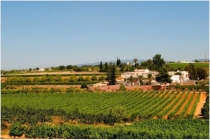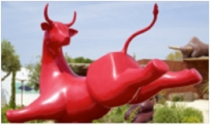Algarve
Wine region: ALGARVE
Situated close to the Straits of Gibraltar, the Algarve has always been on the itinerary of merchant ships of the Mediterranean. For a long time the Tartessians, Phoenicians, and Carthagians lived on the Algarvian coastal resources only. Some traces of viticulture in provincial Roman times, and later the Visigoth period, exist in Milreu, Faro, Boca do Rio and Vilamoura. In AD 711, the Muslim Tariq ibn Ziyad crossed the Straits of Gibraltar and defeated the king of the Visigoths. In 712, Abd al‑Aziz ibn Musa conquered “Al‑Gharb Al‑Andalus”, or the territory “to the west of the Al‑Andalus” During the five centuries of Moorish occupation, it is evident from the culture of the region that apart from officially not being able to drink wine, the Moors continued to practise viticulture, and not only in order to produce table grapes. No only did they plant vineyards, but they also exported wine produced from them.
From the Reconquista of the Algarve in 1249, the Christians took advantage of and improved upon the economic organisation left behind by the Moorish people. Until the proclamation of the Republic, Portuguese monarchs assumed the title of “King of Portugal and of the Algarves”. The Algarve became an important point of departure during the Age of Discovery, and was also an important wine export centre. The 1755 earthquake devastated the region and in the period which followed, the importance of viticulture diminished. Apart from the establishment of cooperatives by the Estado Novo (“New State” of the Republic of Portugal), which was far‑reaching in its extent, restructuring and development of viticulture in general did not occur. Today, however, with quality designations at regional and wine estate level, viticulture in the Algarve is beginning to recover some of its former prestige.
“Given its proximity to the sea, its climate, and crops supported by sophisticated irrigation systems, the Algarve occupied a prominent position within the country at the end of the Middle Ages. Its meridional location and the protection afforded by the mountainous barrier against the cold winds from the north, together with the amphitheatre‑like exposure it received from the south make the climate in the Algarve a markedly Mediterranean one: hot, dry, not very windy, very limited variation in temperature and average insolation above 3,000 hours of sunshine annually. The soils are lithic, non‑humid, comprising sandstone, Silves sandstone or similar, psamitic regossols, red or yellow Mediterranean sandstone and shale, podzols and alluviosols.”
On the initiative of key oenological figures, especially in the Alentejo, varieties adapted to new vinicultural technologies have been introduced. Thanks to considerable investment and technology transfer schemes, modern wine estates and wineries exist in this region today. Given the typicity conferred upon the wines by the edapho‑climatic conditions, there are four Designations of Origin in the Algarve, and it is estimated that there are currently some 2,000 hectares of vineyards devoted to wine production.
The Comissão Vitivinícola do Algarve (Vitivinicultural Commission of the Algarve), abbreviated to CVA, was officially approved as the certification authority mandated to regulate the production, trade and certification of vitivinicultural products entitled to bear the “Lagoa”, “Lagos”, “Portimão” and “Tavira” Designations of Origin (DO) and the geographical indication, “Algarve” IG.
Types of vitivinicultural products
Algarve IG wines or Algarve regional wines: Red, white, rosé, red liqueur, white liqueur.
Lagoa DO, Lagos DO, Portimão DO and Tavira DO wines: Red and white
Regional Contacts
Technical information: COMISSÃO VITIVINÍCOLA DO ALGARVE (Vitivinicultural Commission of the Algarve) Estrada Nacional 125 Bemparece, 8400‑429 Lagoa, Tel. 282341393, Website: www.vinhosdoalgarve.pt
Cultural information on the wine of the region: CONFRARIA DOS ENÓFILOS E GASTRONÓMICA DO ALGARVE (“SOCIETY OF OENOPHILISTS AND GASTRONOMISTS OF THE ALGARVE”); Avenida 5 de Outobro, 8004‑000 Faro; Contact: Confraria dos Gastrónomos do Algarve (“Society of Gastronomists of the Algarve”), Rua Padre Evaristo do Rosário Guerreiro, 11, 8500 Portimão, Mobile: 960 064 967;
Museums, Website: http://algarve.angloinfo.com/af/292/algarve‑museums‑and‑monuments.html
Institutions of higher learning and viticultural research: Universidade do Algarve, Campus da Penha (University of the Algarve, Penha Campus), 8005‑139 Faro; Tel: (351) 289800100; Website: www.ualg.pt; e‑mail:sfp@ualg.pt
Certification authority: COMISSÃO VITIVINÍCOLA DO ALGARVE (Vitivinicultural Commission of the Algarve), Estrada Nacional 125 – Bemparece (IVV premises); 8400‑429 LAGOA, Tel.: 282 341 393, Fax: 282 341 396, e‑mail: cva.direccao@vinhosdoalgarve.pt, Website: www.vinhosdoalgarve.pt
Producer and bottler information on wine from the Lisboa region: http://www.ivv.min‑agricultura.pt/np4/1736.html, → Yearbook, page 250. and in the Algarve itself: Website: http://www.visitalgarve.pt/pressroom.file.php?fileID=32&file=guia_vinhos_09.pdf
Eno‑tourism information: Turismo do Algarve, Av. 5 de Outubro, n.º 18 8000‑076 Faro – PORTUGAL, Tel.: 289 800 400, Fax: 289 800 489, e‑mail: turismodoalgarve@turismodoalgarve.pt; Website: www.turismodoalgarve.pt and www.visitalgarve.pt (there is a link: Wine Guide to the Algarve.)
Designation: IGP “Algarve” Regional wine


Legislation:Ministerial Directive No. 364/2001, Decree‑Law No. 212/2004, Ministerial Directive No. 817/2007, Reg. (EC) No. 479/2008.
RED WINES: Alfrocheiro, Alicante Bouschet, Aragonez (Tinta Roriz), Baga, Bastardo, Cabernet Sauvignon, Caladoc, Castelão (Periquita), Cinsaut, Grand‑Noir, Grenache, Merlot, Monvedro, Moreto, Moscatel Galego Tinto, Negra Mole, Pau Ferro, Petit‑Verdot, Pexem, Pinot Noir, Syrah, Tinta‑Barroca, Tinta Caiada, Tinta Carvalha, Tinto‑Cão, Touriga Franca, Touriga Nacional, Trincadeira (Tinta Amarela)
WHITE WINES: Alicante‑Branco, Antão‑Vaz, Arinto (Pedernã), Chardonnay, Crato Espanhol, Diagalves, Fernão Pires (Maria Gomes), Manteúdo, Malvasia Fina, Malvasia Rei, Moscatel Graúdo, Perrum, Rabo‑de‑Ovelha, Riesling, Sauvignon, Síria (Roupeiro), Tália, Tamarez, Terrantez, Trincadeira‑das‑Pratas, Verdelho and Viognier.
WHITE LIQUEUR WINE: Síria or Moscatel Graúdo.
DOP wines VQPRD


Designation: DOP “Lagos”
Legislation: Decree‑Law No. 299/90, Decree Law No. 318/2003, Reg. (EC) 1493/99.
RED WINES: Castelão (Periquita), Negra Mole and Trincadeira (Tinta Amarela); Alicante Bouschet, Aragonez (Tinta Roriz), Bastardo, Cabernet Sauvignon, Monvedro and Touriga Nacional.
WHITE WINES: Arinto (Pedernã), Malvasia Fina e Síria (Roupeiro), Manteúdo, Moscatel Graúdo and Perrum.
Designation: DOP “Portimão”
Legislation: Decree‑Law No. 299/90, Decree Law No. 318/2003, Reg. (EC) 1493/99.
RED WINES: Castelão (Periquita), Negra Mole and Trincadeira (Tinta Amarela), containing together or separately a minimum of 70% of the specified variety or varieties; Alicante Bouschet, Aragonez (Tinta Roriz), Cabernet Sauvignon, Monvedro, Syrah and Touriga Nacional.
WHITE WINES: Arinto (Pedernã) and Síria (Roupeiro), Manteúdo, Moscatel Graúdo, Perrum and Rabo de Ovelha.
Designation: DOP “Lagoa”
Legislation: Decree‑Law No. 299/90, Decree Law No. 318/2003, Reg. (EC) 1493/99.
RED WINES: Negra Mole and Trincadeira (Tinta Amarela), Alicante Bouschet, Aragonez (Tinta Roriz), Cabernet Sauvignon, Castelão, (Periquita), Monvedro, Moreto, Syrah, Touriga Franca and Touriga Nacional
WHITE WINES: Arinto (Pedernã) and Síria (Roupeiro), Manteúdo, Moscatel Graúdo, Perrum, Rabo de Ovelha and Sauvignon.
Designation: DOP “Tavira”
Legislation: Decree‑Law No. 299/90, Decree Law No. 318/2003, Reg. (EC) 1493/99.
RED WINES: Castelão (Periquita), Negra Mole and Trincadeira (Tinta Amarela), Alicante Bouschet, Aragonez (Tinta Roriz), Cabernet Sauvignon, Syrah and Touriga Nacional
WHITE WINES: Arinto (Pedernã) and Síria (Roupeiro), Diagalves, Manteúdo, Moscatel Graúdo and Tamarez.







